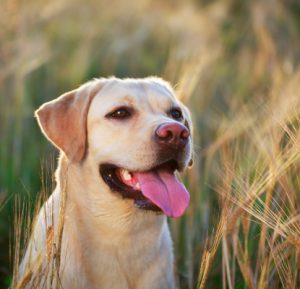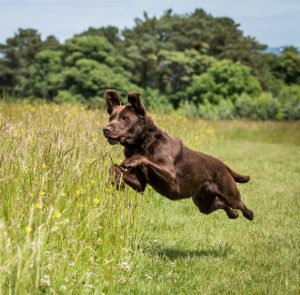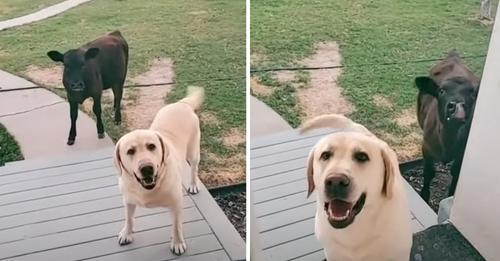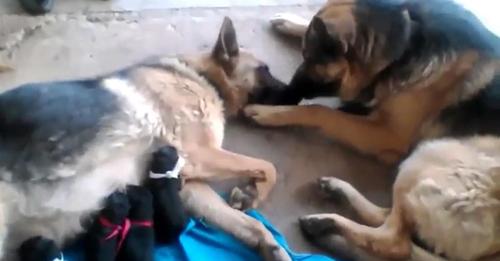The joy and contentment in Labradors is easily recognizable, but it requires a keen eye to truly appreciate. Labradors are known for their expressive nature, using their body language to communicate their emotions effectively. A happy Labrador can be identified by their open mouth, direct gaze, and relaxed tongue. They carry themselves with confidence, their heads held high, especially when they are feeling playful. Their happiness is further evident through their wagging tails and playful gestures, such as bowing down low. By observing their body language closely, we can better understand what brings our furry friends joy and contentment. It is important to pay attention to their mouth and tongue position, facial expressions, eye contact, playful behavior, and tail movements to gauge their happiness levels accurately.
Cheerful Labradors show their happiness by keeping their mouths slightly open, just like the adorable pup in the photo above. This relaxed expression is typical for Labs and is usually the look they sport most of the time. On the other hand, submissive or anxious pups tend to keep their mouths tightly shut or curl their lips back, signaling that something is bothering them. As owners, it’s important for us to pay attention to these early warning signs. A content Labrador will not only have their mouth open but often have their tongue peeking out the side, showing just how carefree and joyful they are.

Sticking out the Tongue and Loose jaw When your cheerful Labrador is feeling good, you’ll likely notice his tongue lazily hanging out of his mouth. This relaxed and natural expression indicates a content pup. However, be cautious if he starts licking his lips when no food is present, as this could signify fear or discomfort. Lip licking, especially paired with a submissive smile, is a clear sign of unease in your furry friend. Making eye contact? While dogs may not typically make prolonged eye contact with each other in the wild, they quickly learn in our homes that locking eyes with their human results in positive reinforcement. A happy dog will happily gaze into your eyes, welcoming attention, pets, or treats. If your dog looks at you sideways or averts its gaze, it may be feeling uneasy or threatened. Keep an eye out for other behavioral cues that could reveal their state of mind. Relaxed Eyes for a Happy Lab A content Labrador’s eyes will appear relaxed, with no excessive white showing. If your dog is sidelong glancing with whites of their eyes visible, they might be feeling uneasy. Happy Labs will have relaxed eyes, with a comfortable demeanor and no anxious head positioning. The joyful Labrador in the photo above exemplifies this, looking confidently at their owner with relaxed eyes, natural ear position, and a proud stance.

Natural ear position is an important indicator of a Labrador’s mood. Most Labradors have ears that point up and then flop over to varying degrees. A happy Labrador will have ears sitting naturally in a relaxed position, while raised ears show alertness and listening, and flattened or sideways ears indicate fear or submission. The head position of a dog also speaks volumes. A proud and upright head signifies confidence and happiness, while a bowed head can indicate worry. Dogs, like humans, use their head movements to convey feelings of submission or confidence. One common gesture that indicates a happy and playful dog is the play bow, where the dog lowers their front end by bending their forepaws. This gesture shows a desire to engage and play, making it clear that the dog is happy and excited. When a dog runs, the way they move can also reveal their mood. A cheerful and happy dog will have a bouncing run with more movement in the vertical plane compared to a regular stride. This joyful movement is a clear sign of a happy dog, whether they are greeting a friend in the park or skipping around you on a walk.

In contrast to popular belief, a dog’s wagging tail doesn’t always signify happiness. It can actually serve as a warning sign, indicating feelings of threat or nervousness depending on the tail position and movement. A happy dog’s tail will sway in a natural, rapid motion with a relaxed and fluid motion. However, the absence of wagging doesn’t necessarily mean the dog is unhappy. This is why the importance of a relaxed tail is often overlooked but crucial in deciphering a dog’s emotions. A content Labrador might exhibit a tail that acts like a broom, swaying back and forth joyfully. But if the tail remains still, it doesn’t automatically mean the dog is sad. Fearful dogs typically tuck their tails between their legs, while threatened dogs may hold their tails high and stiff. In the case of happy dogs, their tails may simply hang naturally around their hocks, moving loosely as they walk with a gentle sway in their back end. Understanding your dog’s body language can provide valuable insights into their emotional state and help maintain their happiness. If you have other methods to determine your dog’s happiness, feel free to share them in the comments below!




